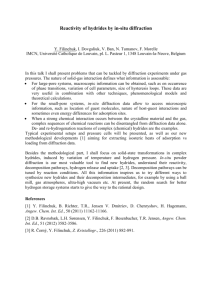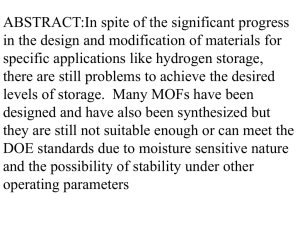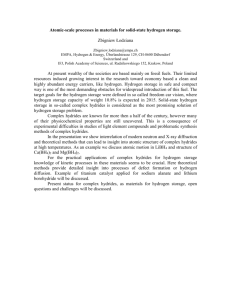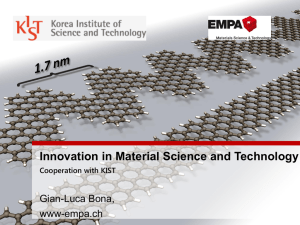Semiconducting hydrides
advertisement
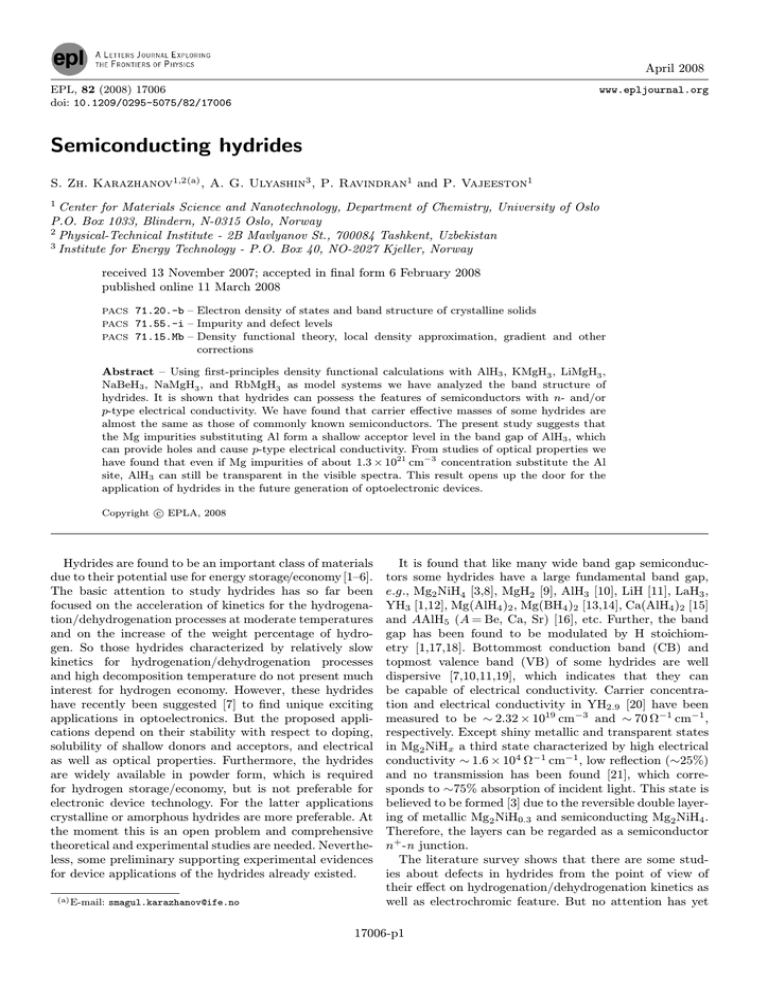
April 2008 EPL, 82 (2008) 17006 doi: 10.1209/0295-5075/82/17006 www.epljournal.org Semiconducting hydrides S. Zh. Karazhanov1,2(a) , A. G. Ulyashin3 , P. Ravindran1 and P. Vajeeston1 1 Center for Materials Science and Nanotechnology, Department of Chemistry, University of Oslo P.O. Box 1033, Blindern, N-0315 Oslo, Norway 2 Physical-Technical Institute - 2B Mavlyanov St., 700084 Tashkent, Uzbekistan 3 Institute for Energy Technology - P.O. Box 40, NO-2027 Kjeller, Norway received 13 November 2007; accepted in final form 6 February 2008 published online 11 March 2008 PACS PACS PACS 71.20.-b – Electron density of states and band structure of crystalline solids 71.55.-i – Impurity and defect levels 71.15.Mb – Density functional theory, local density approximation, gradient and other corrections Abstract – Using first-principles density functional calculations with AlH3 , KMgH3 , LiMgH3 , NaBeH3 , NaMgH3 , and RbMgH3 as model systems we have analyzed the band structure of hydrides. It is shown that hydrides can possess the features of semiconductors with n- and/or p-type electrical conductivity. We have found that carrier effective masses of some hydrides are almost the same as those of commonly known semiconductors. The present study suggests that the Mg impurities substituting Al form a shallow acceptor level in the band gap of AlH3 , which can provide holes and cause p-type electrical conductivity. From studies of optical properties we have found that even if Mg impurities of about 1.3 × 1021 cm−3 concentration substitute the Al site, AlH3 can still be transparent in the visible spectra. This result opens up the door for the application of hydrides in the future generation of optoelectronic devices. c EPLA, 2008 Copyright Hydrides are found to be an important class of materials due to their potential use for energy storage/economy [1–6]. The basic attention to study hydrides has so far been focused on the acceleration of kinetics for the hydrogenation/dehydrogenation processes at moderate temperatures and on the increase of the weight percentage of hydrogen. So those hydrides characterized by relatively slow kinetics for hydrogenation/dehydrogenation processes and high decomposition temperature do not present much interest for hydrogen economy. However, these hydrides have recently been suggested [7] to find unique exciting applications in optoelectronics. But the proposed applications depend on their stability with respect to doping, solubility of shallow donors and acceptors, and electrical as well as optical properties. Furthermore, the hydrides are widely available in powder form, which is required for hydrogen storage/economy, but is not preferable for electronic device technology. For the latter applications crystalline or amorphous hydrides are more preferable. At the moment this is an open problem and comprehensive theoretical and experimental studies are needed. Nevertheless, some preliminary supporting experimental evidences for device applications of the hydrides already existed. (a) E-mail: smagul.karazhanov@ife.no It is found that like many wide band gap semiconductors some hydrides have a large fundamental band gap, e.g., Mg2 NiH4 [3,8], MgH2 [9], AlH3 [10], LiH [11], LaH3 , YH3 [1,12], Mg(AlH4 )2 , Mg(BH4 )2 [13,14], Ca(AlH4 )2 [15] and AAlH5 (A = Be, Ca, Sr) [16], etc. Further, the band gap has been found to be modulated by H stoichiometry [1,17,18]. Bottommost conduction band (CB) and topmost valence band (VB) of some hydrides are well dispersive [7,10,11,19], which indicates that they can be capable of electrical conductivity. Carrier concentration and electrical conductivity in YH2.9 [20] have been measured to be ∼ 2.32 × 1019 cm−3 and ∼ 70 Ω−1 cm−1 , respectively. Except shiny metallic and transparent states in Mg2 NiHx a third state characterized by high electrical conductivity ∼ 1.6 × 104 Ω−1 cm−1 , low reflection (∼25%) and no transmission has been found [21], which corresponds to ∼75% absorption of incident light. This state is believed to be formed [3] due to the reversible double layering of metallic Mg2 NiH0.3 and semiconducting Mg2 NiH4 . Therefore, the layers can be regarded as a semiconductor n+ -n junction. The literature survey shows that there are some studies about defects in hydrides from the point of view of their effect on hydrogenation/dehydrogenation kinetics as well as electrochromic feature. But no attention has yet 17006-p1 S. Zh. Karazhanov et al. 6 6 4 4 2 Energy (eV) been paid to the question as to the effect of the impurities on electrical conductivity of hydrides. Calculated effective masses of some hydrides are found [7,19] to be almost the same as those of semiconductors. Moreover, the ab initio calculations on Ca and Mg impurities substituting Al in orthorhombic AlH3 show [7] shallow acceptor levels thus indicating the tendency to contribute to p-type electrical conductivity. Impurities of Si substituting Al in hexagonal AlH3 can form shallow donor level resulting in n-type electrical conductivity [7]. In addition, even at high concentrations of Mg and Ca (∼ 6.1 × 1020 cm−3 ), α-AlH3 has been shown [7] to remain transparent to the visible light. Using AlH3 , KMgH3 , LiMgH3 , NaBeH3 , NaMgH3 , and RbMgH3 as examples, here we show that hydrides possess the features of semiconductors, namely, well-dispersed topmost VB, small carrier effective masses, p-type electrical conductivity, and finite fundamental band gap. Vienna ab initio simulation package (VASP) [22,23] has been used for the present study along with the generalizedgradient approximation of Perdew-Wang [24]. The interaction between ions and electrons is described using the projector augmented wave (PAW) method. For primitive unit cells the self-consistent calculations were performed using a 10 × 10 × 10 mesh of special k-points. For studies of defects 2 × 1 × 2 supercell have been used for all types of the lattices considered. All configurations were fully relaxed using the conjugate gradient method. The planewave cutoff energy of 500 eV was used for all the calculations. The convergence was achieved when the forces acting on the atoms were less than 2 meV Å−1 and the total energy difference between two consecutive iterations was < 10−6 eV/cell. The convergence criteria and more details about the optical calculations were discussed in ref. [25]. The imaginary part of the optical dielectric function has been derived by summing all allowed transitions from occupied to unoccupied states for energies much higher than those of the phonons. It is used to derive the reflectivity and absorption coefficients. More details about the optical calculations were discussed in ref. [25]. We have studied the band structure and optical properties of cubic AlH3 (also known as β-AlH3 ), cubic KMgH3 , rhombohedral LiMgH3 , tetragonal NaBeH3 , orthorhombic NaMgH3 , hexagonal RbMgH3 , and doped β-AlH3 . The choice of the hydrides for the present study is based on their large fundamental band gap [11], e.g., the band gap for hexagonal AlH3 calculated by the density functional theory (DFT) using the GW approximation (“G” stands for one-particle Green’s function as derived from many-body perturbation theory and “W” for Coulomb screened interactions) is 3.5 eV [11]. Furthermore, the cubic AlH3 (β-AlH3 ) is energetically more stable than the other polymorphs [10] and can be synthesized in bulk. It exhibits dehydriding reactions in the temperature range of 60–200 ◦ C (ref. [26]), 330 ◦ C (ref. [27]), which is well above the operable range of optoelectronic devices. According to ref. [28], one can store AlH3 for several years without any loss of hydrogen. However, the hydrogen decomposition β−AlH3 2 0 0 -2 -2 -4 X -4 Γ L UX W L Γ KW 4 2 X M Γ R M Γ R M 4 2 RbMgH3 0 0 -2 -2 A KMgH3 L M Γ A H K Γ NaBeH3 Γ X M Fig. 1: Band dispersion for β-AlH3 , KMgH3 , RbMgH3 , and NaBeH3 . Fermi level is set at zero energy. is reported to be enhanced by doping, particle size [29] and vacancy concentration [29,30]. Anyhow, here we use β-AlH3 , KMgH3 , NaBeH3 , and RbMgH3 as model systems only to demonstrate that hydrides can possess p-type conductivity and transparency to the visible part of the solar spectrum. Thus, we leave the problem of finding a more suitable hydride for the future studies. Optimized structural parameters have been found in refs. [5,6]. For doped AlH3 we have considered Mg impurity substituting Al (MgAl ) as a candidate for shallow level acceptor-type defects. The primitive unit cell of cubic AlH3 consists of 16 atoms, whereas for the studies of defects we have considered a supercell with 64 atoms derived from 2 × 1 × 2 of the conventional cell. The band structure of the above-mentioned hydrides has been studied. The results have been presented for AlH3 , KMgH3 , RbMgH3 , and NaBeH3 (fig. 1). It is found that the calculated fundamental band gap is 2.6 eV for KMgH3 , 1.5 eV for NaBeH3 and 2.5 eV for RbMgH3 . Commonly, the fundamental band gap calculated from DFT is smaller than that derived from optical measurements. So, one can expect that the actual band gap for these materials will be larger than that listed above. The topmost VB and the bottommost CB of KMgH3 , NaBeH3 , and NaMgH3 are found to be well dispersive resulting in small carrier effective masses, where the calculated directiondependent effective masses indicate that the conductivity will be highly anisotropic. Among the hydrides considered for the present study, RbMgH3 and AlH3 posses well-dispersed and nearly isotropic topmost VB as well as bottommost CB. Here, we shall concentrate our attention on AlH3 . Figure 1 displays the band structure for β-AlH3 where the CB minimum and VB maximum are located at the X- and Γ-point, respectively, indicating that AlH3 is an indirect band gap material. The calculated direct and indirect band gaps are 3.5 eV and 3.0 eV, 17006-p2 Semiconducting hydrides -1 -1 -1 0.08 0.04 H 0.16 1.6 -1 0.12 EF -1 Al s p 0.16 PDOS (States eV fu atom ) Total DOS (States eV fu ) EF 1.2 0.8 0.4 0.12 -2 -1 0.08 0.04 0 1 2 3 Energy (eV) 4 Fig. 3: Total DOS for Mg-doped β-AlH3 . The Fermi level is set to zero energy. -3 -2 -1 0 1 2 Energy (eV) 3 4 Fig. 2: Orbital and site projected DOS for β-AlH3 . The Fermi level is set to zero energy. respectively. As the bottommost part of the CB is less dispersive, one cannot expect much contribution to electrical conductivity from CB electrons. However, the topmost VB is much more dispersive than the bottommost CB indicating that the electrical current transport in AlH3 can be determined basically by holes. The well-dispersed nature of the topmost VB indicates the presence of a considerable covalent bonding between Al and H in agreement with the density of states (DOS) and charge density analysis [10]. For the quantitative characterization of the band dispersion the effective masses of holes (mh ) have been calculated, which are equal to mh = 0.60m0 along the Γ-X direction and mh = 0.48m0 along the Γ-L one demonstrating a slight anisotropy in the conductivity. However, the magnitude of the masses is much smaller along Γ||A or comparable along Γ ⊥ A than that for ZnO (2.74m0 (2.27m0 ) along Γ||A and 0.54m0 (0.35m0 ) along Γ ⊥ A from the FP-LMTO (plane-wave pseudopotential [31]) method [32]). In order to clarify the character of the bands in the vicinity of the fundamental gap in hydrides the orbital and site projected DOS for AlH3 are plotted in fig. 2. The analysis shows that the bottommost CB is basically contributed by Al 3s-electrons, whereas the topmost VB is contributed by H 1s-electrons. This is one of the distinguishing features of some hydrides compared to conventional semiconductors where the topmost VB is commonly originated from p-/d -electrons and the bottommost CB from s-electrons. To our knowledge, there is no report on semiconductors with s-type electrons at the topmost VB. As pointed out in the above analysis of the band structure (fig. 1) and effective masses, holes are capable to contribute well to electrical conductivity in AlH3 . However, upon heavy doping with shallow acceptors, not only the conductivity can be enhanced but also the optical properties can be changed considerably. We have also studied structural properties, electronic structure, and optical spectra of Mg-substituted AlH3 . From structural studies we have found that the volume difference between the ideal and Mg-doped β-AlH3 does not exceed 2%. Furthermore, the calculated formation energy for the Mg-doped β-AlH3 is −2.0 eV, which shows that such configuration is energetically stable. Figure 3 displays the total DOS for the Mg-doped AlH3 , which shows that the Mg substitution for Al in AlH3 induces a shallow level acceptor. Hence, MgAl can provide free holes and thus contribute to electrical conductivity. Figure 4 shows the calculated optical spectra for AlH3 : MgAl , which indicates that despite heavy doping with Mg, transparency has not been changed much in the energy range 0–4 eV. Consequently, AlH3 can be a well-conducting material and at the same time be transparent to the visible range of the optical spectrum. It may be noted that the band gap obtained from DFT 17006-p3 S. Zh. Karazhanov et al. 2.0 MgAl Ideal MgAl Ideal 0.6 ×10 1.2 −5 R(ω) -1 α(ω) (cm ) 1.6 0.4 0.8 0.2 0.4 4 8 12 16 4 8 12 16 Energy (eV) Fig. 4: Absorption coefficient α(ω) and reflectivity R(ω) for ideal and MgAl -doped β-AlH3 . calculations is commonly underestimated due to the artificial shift by the CB toward lower energies. So, in the real case, β-AlH3 can be transparent in a wider energy range of photons than that predicted from the present optical calculations. In conclusion, using DFT calculations we have demonstrated that several hydrides are capable of n- and p-type electrical conductivity and at the same time transparent to the visible range of the optical spectrum. This can extend the class of semiconducting materials and be important in the low-temperature optoelectronic device manufacturing technology. Distinct from other semiconductors, hydrides can have added advantages such as passivation of defects, improvement in interface problems, avoiding of band off-sets, etc. On the one hand, the present results extend the list of possible applications of hydrides by revealing their semiconducting feature and, on the other hand, we opened up the door for the application of hydrides in the future generation of electronic devices called “hydride electronics”. Studies about stability, transparency, and feasibility of the n- and p-type conductivity for the hydrides are the subjects for detailed investigations in the near future. ∗∗∗ This work has received financial and supercomputing support from the Research Council of Norway within NANOMAT project and from the Academy of Sciences of Uzbekistan. REFERENCES [1] Huiberts J. N., Griessen R., Rector J. H., Wijnaarden R. J., Dekker J. P., deGroot D. G. and Koeman N. J., Nature, 380 (1996) 231. [2] Kerssemakers J. W. J., Molen S. J. v. d., Koeman N. J., Günther R. and Griessen R., Nature, 406 (2000) 489. [3] Lohstroh W., Westerwaal R. J., Noheda B., Enache S., Giebels I., Dam B. and Griessen R., Phys. Rev. Lett., 93 (2004) 197404. [4] Schlapbach L. and Zuttel A., Nature, 414 (2001) 353. [5] Vajeeston P., in Theoretical Modelling of Hydrides, PhD Thesis, Department of Physics, Faculty of Mathematics and Natural Sciences (The University of Oslo, Oslo) 2004, ISSN 1501-7710, No 390. [6] Klaveness A., in Quantum mechanical modelling and complex hydrides, PhD Thesis, Faculty of Mathematics and Natural Sciences (The University of Oslo, Oslo, Norway, Oslo) 2007, ISSN 1501-7710, No 629. [7] Karazhanov S. Z., Ravindran P., Vajeeston P. and Ulyashin A. G., Phys. Stat. Solidi (a), 204 (2007) 3538. [8] Westerwaal R. J., Slaman M., Broedersz C. P., Borsa D. M., Dam B., Griessen R., Borgschulte A., Lohstroh W., Kooi B., ten Brink G., Tschersich K. G. and Fleischhauer H. P., J. Appl. Phys., 100 (2006) 063508. [9] Vajeeston P., Ravindran P., Kjekshus A. and Fjellvåg H., Phys. Rev. Lett., 89 (2002) 175506. [10] Ke X. Z., Kuwabara A. and Tanaka I., Phys. Rev. B, 71 (2005) 184107. [11] van Setten M. J., Popa V. A., de Wijs G. A. and Brocks G., Phys. Rev. B, 75 (2007) 035204. [12] den Broeder F. J. A., van der Molen S. J., Kremers M., Huiberts J. N., Nagengast D. G., van Gogh A. T. M., Huisman W. H., Koeman N. J., Koeman N. I., Dam B., Rector J. H., Plota S., Haaksma M., Hanzen R. M. N., Jungblut R. M., Duine P. A. and Griessen R., Nature, 394 (1998) 656. [13] Vajeeston P., Ravindran P., Kjekshus A. and Fjellvag H., Appl. Phys. Lett., 89 (2006) 071906. [14] Lovvik O. M. and Molin P. N., Phys. Rev. B, 72 (2005) 073201. [15] Lovvik O. M., Phys. Rev. B, 71 (2005) 144111. [16] Klaveness A., Vajeeston P., Ravindran P., Fjellvag H. and Kjekshus A., J. Alloys Compd., 433 (2007) 225. [17] Lohstroh W., Westerwaal R. J., Lokhorst A. C., van Mechelen J. L. M., Dam B. and Griessen R., J. Alloys Compd., 404 (2005) 490. [18] Vajda P. and Daou J. N., Phys. Rev. Lett., 66 (1991) 3176. [19] Karazhanov S. Z., Ulyashin A. G., Ravindran P. and Vajeeston P., submitted to Appl. Phys. A. [20] Romijn I. G., Pronin A. V., Brom H. B. and Hoekstra A. F. T., Phys. Rev. B, 70 (2004) 193106. [21] Isidorsson J., Giebels I., Griessen R. and Di Vece M., Appl. Phys. Lett., 80 (2002) 2305. [22] Kresse G. and Hafner J., Phys. Rev. B, 47 (1993) 558. [23] Kresse G. and Furthmüller J., Phys. Rev. B, 54 (1996) 11169. [24] Perdew J. P., Burke K. and Ernzerhof M., Phys. Rev. Lett., 77 (1996) 3865. [25] Karazhanov S. Z., Ravindran P., Kjekshus A., Fjellvag H. and Svensson B. G., Phys. Rev. B, 75 (2007) 155104. [26] Orimo S., Nakamori Y., Kato T., Brown C. and Jensen C. M., Appl. Phys. A: Mater. Sci. Proc., 83 (2006) 5. [27] Graetz J. and Reilly J. J., J. Phys. Chem. B, 109 (2005) 22181. 17006-p4 Semiconducting hydrides [28] Turley J. W. and Rinn H. W., Inorg. Chem., 8(1969)18. [29] Sandrock G., Reilly J., Graetz J., Zhou W. M., Johnson J. and Wegrzyn J., J. Alloys Compd., 421 (2006) 185. [30] Wolverton C., Ozolins V. and Asta M., Phys. Rev. B, 69 (2004) 144109. [31] Karazhanov S. Z., Ravindran P., Kjekshus A., Fjellvag H., Grossner U. and Svensson B. G., J. Appl. Phys., 100 (2006) 043709. [32] Lambrecht W. R. L., Rodina A. V., Limpijumnong S., Segall B. and Meyer B. K., Phys. Rev. B, 65 (2002) 075207. 17006-p5
